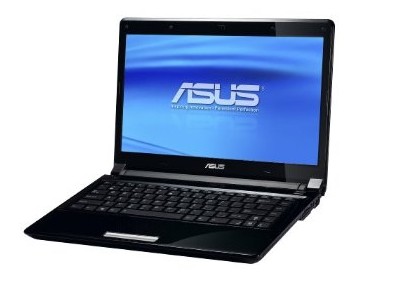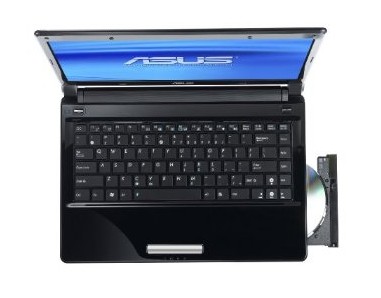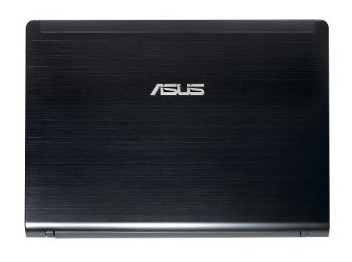Asus UL80Vt-A1
Especificaciones de Portátil(es)

Price comparison
Promedio de 4 puntuaciones (de 5 análisis)
Análisis para el Asus UL80Vt-A1
Origen: Laptop Mag
 EN→ES Archive.org version
EN→ES Archive.org versionOf the numerous 14-inch Optimus notebooks we've reviewed so far, the ASUS UL80Jt stands out as one of the best. For $869, you get excellent endurance for a system this size without sacrificing too much performance. If you're looking for something with a little more graphics muscle, then the Gateway ID49C08u ($849) is the better option. But if all-day mobility trumps gaming prowess, then the UL80Jt is the way to go.
Único Análisis, disponible online, Mediano, Fecha: 08/18/2010
Puntuación: Puntuación total: 80%
Origen: PC World
 EN→ES Archive.org version
EN→ES Archive.org versionAsus has its work cut out for it in finding a market for the UL80Vt-A1. This ultraportable laptop has a higher price ($849) than many similarly specced competitors, though it's in the same ballpark as its $800 stablemate, the Asus UL30A. So how does Asus justify the price tag? The UL80Vt-A1 covers its base respectably. Strong battery life and surprisingly responsive performance give Asus's latest rig two solid legs to stand on. The only major drawbacks here are the price and that wretched mouse.
Único Análisis, disponible online, Mediano, Fecha: 11/23/2009
Puntuación: Puntuación total: 60%
Origen: PC Mag
 EN→ES Archive.org version
EN→ES Archive.org versionWhen laptops equipped with consumer ultra low-voltage (CULV) processors first came on the market, they tended to be minimalist in design—much like the first netbooks—and focused on having a sleek form factor more than anything else. Like netbooks, these laptops eventually evolved into larger, more capable systems. Indeed, the first CULV laptops were razor thin, like the MSI X340, Acer Aspire Timeline AS3810T, and the Editors' Choice ASUS UL30A-A1. The CULV-equipped ASUS UL80Vt-A1 laptop is loaded with lovable features, including switching graphics technology, a huge battery, and a metallic design.
Único Análisis, disponible online, Mediano, Fecha: 11/02/2009
Puntuación: Puntuación total: 90%
Origen: Notebookreview.com
 EN→ES Archive.org version
EN→ES Archive.org versionThe ASUS UL80Vt is a 14” thin-and-light laptop with 10 hours of battery life, an overclocked processor, and switchable Nvidia graphics. Read on to find out if this battery-friendly powerhouse is worth your money. The ASUS UL80Vt is a notebook we really want to like but has too many drawbacks to overwhelmingly recommend. While it has a stellar ten-hour battery life, sleek design, and good overall performance, its weak build quality, abysmal keyboard, and unfriendly touchpad prevent us from signing its praises.
Único Análisis, disponible online, largo, Fecha: 11/01/2009
Puntuación: rendimiento: 80% pantalla: 50% movilidad: 80% procesamiento: 30% emisiones: 90%
Origen: Laptop Mag
 EN→ES Archive.org version
EN→ES Archive.org versionThis lightweight powerhouse combines good graphics punch with over 9 hours of battery life.
The ASUS UL80Vt costs more than other ULV thin-and-light notebooks, but it’s worth the extra money for the better graphics performance. If you’re looking for something lighter and don’t need an optical drive, you may want to consider either the 4.4-pound Dell Studio 14z or the 13-inch ASUS UL30A, which weighs only 4.0 pounds. But if you want all-day battery life and good performance in a sleek 14-inch system, the UL80Vt is a very good choice.Único Análisis, disponible online, largo, Fecha: 10/29/2009
Puntuación: Puntuación total: 80%
Comentario
NVIDIA GeForce G210M: La Nvidia GeForce GTS 210 M es un adaptador gráfico DirectX 10.1 para portátiles basado en el núcleo GT218. Como su predecesor, presenta 16 shaders pero la velocidad de reloj ha sido muy disminuida. Debido al proceso de 40 nm (comparado con el proceso de 55 nm de la G110M) el máximo consumo de corriente se mantiene igual.
El núcleo de la G210M es llamado internamente GT218 y según Nvidia esta basado en la arquitectura de escritorio actual de gama alta (gama GTX 200). Además, Nvidia ha mejorado la micro arquitectura para mayor ahorro de energía e incrementos de rendimiento. Por tanto, el rendimiento por unidad shade debería ser ligeramente mejor que la generación anterior.
Estos procesadores gráficos pueden mostrar únicamente juegos antiguos, fluidamente. Juegos actuales pueden ser presentados con detalles sustancialmente reducidos.
>> Más información puede ser encontrada en nuestra comparación de tarjetas gráficas moviles y la lista de benchmarks.
Intel Core 2 Duo: Este es el sucesor Core Duo y el Core Solo con un pipeline más largo y con una velocidad entre 5-20% sin mayor consumo de energía. Adicional al diseño de Core Duo existe un cuarto decodificador, una unidad SSE ampliada y una unidad lógica aritmética (ALU) adicional.
Sus características son: 2 núcleos (cores), una amplificación de comando de 64-bit EM64T y 2 o 4 MB L2 Cache y 291 millones de transistores, que son acabados en 65nm. Mas allá de esto, todos los tipos soportan técnicas "Execute Disable Bit", SSSE3 (SSE4), Enhanced Speedstep, LaGrande y la mayoría de técnicas de virtualizacion (VT) Vanderpool.
El Core 2 Duo para laptops es idéntico a los procesadores Core 2 Duo para desktops, pero los procesadores para notebooks trabajan con tensiones más bajas (0.95 a 1188 Volt) y un Frontside bus clock (1066 contra 667 MHz). El rendimiento de laptops cuena con una frecuencia de 20-25% más baja que PCs Desktop debido a una frecuencia más baja de Frontside bus y los discos duros más lentos.
SU7300: Lento procesador dual core con un TDP bajo de 10 Watts.
>> Más información puede ser encontrada en nuestra comparación de procesadores móviles.







